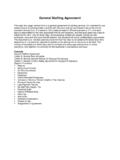Transcription of Canadian Staffing Industry Outlook - Home - ACSESS
1 Confidential Report NOT for Distribution | 2015 by Crain Communications Inc. All rights Staffing Industry OutlookMay 2015 May 5, 2015 Timothy Landhuis, Research AmericaCanadian Staffing Industry Outlook | May 5, 2015 Confidential Report NOT for Distribution | 2015 by Crain Communications Inc. All rights Staffing Industry Outlook : May 20151 Key Findings The Canadian economy is expected to grow a modest in 2015, but accelerate to expansion in 2016. The sharp drop in oil prices in 2H2014 has caused GDP growth in Alberta to shift from in 2014 to a projected in 2015, dragging down Canada s overall GDP growth. However, in 2015, growth in British Columbia, Ontario, and Quebec is projected to be a relatively healthy , , and , respectively.
2 The recent weakness in the Canadian dollar and strength in the dollar is expected to spur growth in Canada s exports, which comprise roughly 30% of its GDP. Export industries expected to grow include aircraft and parts, industrial machinery, pharmaceuticals, building and packaging materials, and fabricated metal, according to the Bank of Canada. These industries may represent growth opportunities for Staffing firms. We forecast that temporary Staffing Industry (which includes Staffing suppliers of both T4 recipients and independent contractors) revenue will decline 2% in 2015 to reach a market size of CAD billion, in part because of its large exposure to cutbacks in the oil and gas sector. However, we project a rebound to 6% growth in 2016 as our forecast assumes acceleration in GDP growth and stabilization in oil prices.
3 In addition, we forecast 3% growth in 2015 and 8% growth in 2016 in place and search (direct hire, retained search, and temp-to-hire) revenue. The stronger growth rates in place and search are due to our assumption that it has less exposure than temporary Staffing to the oil and gas sector. We estimate the temporary Staffing Industry in 2014 consisted of roughly 50% Staffing of professional workers and 50% commercial workers (either office/clerical or industrial blue collar workers) by revenue. We estimate the following revenue proportions by skill segment of the worker supplied: IT Staffing (25% of temporary Staffing Industry revenue), engineering (14%), finance/accounting (5%), healthcare (2%), and other professional (4%).
4 Ontario, Alberta, Quebec, and British Columbia accounted for 96% of Employment Services Industry revenue, according to a report by Statistics Canada regarding 2012 activity. In addition, the six largest metro areas Toronto, Montreal, Vancouver, Calgary, Edmonton, and Ottawa account for roughly half the population of Canada, making them key locations of Staffing Staffing Industry Outlook | May 5, 2015 Confidential Report NOT for Distribution | 2015 by Crain Communications Inc. All rights GDP growth expected in 2015 due to oil price shock2 The Canadian economy achieved solid growth through most of the past decade as shown in the top graph. It is noteworthy that Canada weathered the global recession of 2008-2009 better than other large economies thanks in part to the health of its banking sector (Canada GDP declined for only one year in 2009 versus GDP declines in 2008 and 2009.)
5 In the current time frame, Canada GDP growth is being negatively impacted by the roughly 50% drop in oil prices that occurred in the second half of 2014 (see graph below.) Along with layoffs at oil and gas firms and suppliers, a negative ripple effect is expected to hit tax revenues, financiers, and local businesses in oil production areas. (In addition, oil and gas operations due to their project nature have been a disproportionately large buyer of Staffing services.) On a more positive note, Canada GDP growth is expected to benefit in the near term from growth in exports. The recent appreciation of the US dollar should make Canadian goods and services more attractively priced to buyers in the , who purchase roughly 70% of Canadian exports.
6 Export industries expected to grow include aircraft and parts, industrial machinery, pharmaceuticals, building and packaging materials, and fabricated metal, according to the Bank of Canada. See page 10 for more details on export industries. We note that the 2015 GDP Outlook varies significantly among the four most populous provinces: Ontario (+ ), Quebec (+ ), British Columbia (+ ), and Alberta (+ ). Alberta faces a tough 2015 due to the oil shock, while Ontario is expected to benefit from growth in manufacturing. See page 9for more real GDP growth, 2005 to 2016 PSource: World Bank; 2015 and 2016 projections from Bank of Canada Monetary Policy Report April oil prices (WTI benchmark), 2014-2015 Source: Energy Information Administration02040608010012020142015 Canadian Staffing Industry Outlook | May 5, 2015 Confidential Report NOT for Distribution | 2015 by Crain Communications Inc.
7 All rights growth weak in 2014, unemployment rate at pre-recession levels3 Despite GDP growth of in 2014, total employment growth for Canada was a surprisingly weak in 2014, as shown in the top graph. Job growth was sluggish even in the first half of 2014 before the drop in oil prices. The growth rate is disappointingly low given that Canada s population has been growing steadily at a annual average rate from 2007-2013, according to the latest figures from the World Bank. Some analysts point to Canada s aging population and retirees exiting the workforce as a factor putting downward pressure on employment growth. On a brighter note, employment growth has accelerated slightly in the first three months of 2015.
8 During this period, Canada gained 63,000 jobs. The unemployment rate was in March 2015, one percentage point above the low point of reached in October of 2007, before the last change in Canada employment (3 mo. avg.),2007-2015 Source: Statistics Canada, LabourForce SurveyCanada unemployment rate, 2000-2015 Source: Statistics Canada, LabourForce Survey0%1%2%3%4%5%6%7%8%9%10%20002001200 2200320042005200620072008200920102011201 2201320142015 Canadian Staffing Industry Outlook | May 5, 2015 Confidential Report NOT for Distribution | 2015 by Crain Communications Inc. All rights hours survey shows trend of Staffing volume decline starting in 20144 The Canadian Staffing Index, a survey of the monthly volume of billed hours for temporary Staffing from a panel of leading Staffing firms in Canada, has shown a trend of single-digit year-over-year declines starting in 2014.
9 We note that as the Canadian Staffing Index reflects trends in total hours, it is more reflective of trends in the lower pay-rate Staffing segments (industrial and office/clerical) because these lower pay-rate positions account for roughly 80 percent of total hours billed by Staffing firms. In terms of revenue dollars, the industrial and office/clerical segments (due to their lower bill rates) represent only 50 percent. More discussion of skill segment market sizes can be found on page change in the Canadian Staffing Index (3 mo. avg.)* Source: Association of Canadian Search, Employment and Staffing Services ( ACSESS ) and Staffing Industry Analysts*The index reflects volume of billed hours each month from a panel of leading Staffing firms in Canada, with the index value of 100 equal to the size of the Industry in July 2008.
10 The index is produced by Staffing Industry Analysts in partnership with Staffing Industry Outlook | May 5, 2015 Confidential Report NOT for Distribution | 2015 by Crain Communications Inc. All rights Staffing Industry projected to decline slightly in 2015 and return to growth in 20165 We estimate the size of the temporarystaffing Industry in Canada in 2014 to be CAD billion in revenue. (A breakdown of the temporary Staffing Industry by skill segment can be found on the next page.) Note that temporary Staffing includes revenue from supplying T4 recipients (equivalent of W-2 form employees in the ) and independent contractors. Place and search revenue (direct hire, retained search, and temp-to-hire conversion fees) amounted to CAD billion by our estimates.










